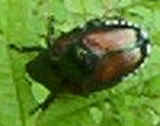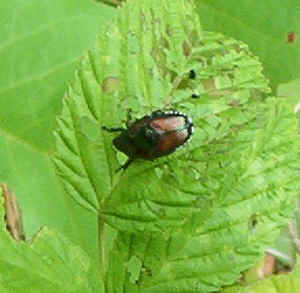 |
 |
Japanese Beetle
Scientific Name: Popilla japonica
Family Name: Scarabaeidae
Serendipity Ranch
Columbus, North Carolina
 |
 |
Shining Leaf Chafers, Subfamily Rutelinae. Adults feed on foliage and fruit; larvae feed on roots. Some species are very colorful, and a number are serious pests. Members of this subfamily are distinctive for having tarsal claws of unequal length, especially on the hind legs. The Japanese Beetle, Popillia japonica, is probably the most injurious species of the family. It causes far more damage in this country than in Japan, its native habitat. First found in New Jersey about 1916, it has since spread to much of the northeast U.S. Its larvae feed on roots of many different plants, and are especially destructive in lawns, parks, golf courses, and pastures. Adults feed on foliage, flowers, and fruit of many different plants; damage is often severe when these beetles feed in groups. They are most active on warm sunny days. [White, Richard E., Peterson Field Guide Series: A Field Guide to the Beetles of North America, Houghton Mifflin Company, Boston, 1983]
3/8-1/2". Oval, sturdy. Body bright metallic green; elytra mostly brownish or reddish orange. Grayish hair on underside and 5 patches of white hair along each side of abdomen with 2 white tufts at tip. Male has pointed tibial spurs; female's are rounded. Habitat: Open woods and meadows. Range: Maine to South Carolina. Food: Adult damages leaf tissues and ripening fruit of more than 200 plants, including vines, flowers, shrubs, and trees. Larva feeds on roots, especially those of grasses, vegetables, and nursery plants. Life Cycle: Elongate, yellowish-white eggs are deposited on soil, 1-4 at a time. Fully grown larvae overwinter in soil and pupate in the spring. 1 generation of adults emerges in summer when blackberries ripen. In the North, cycle takes 2 years. The Japanese Beetle was introduced accidentally in 1916 on iris roots imported from Japan and has been a major pest for years. Its numbers have been reduced by the controlled use of parasitic tachnid flies and tiphiid wasps that prey on beetle larvae. [Milne, Lorus and Margery, National Audubon Society Field Guide to North American Insects and Spiders, Alfred A. Knopf, New York, 1980]